How Do the Japanese Celebrate Valentine's Day? || Find Out First
Valentine’s Day in Japan 💝 How do Japanese Spend This Romantic Day?

Are you excited about February 14th?
Although Valentine’s Day in Japan is quite different from the Western tradition, this is the most romantic day in Japan too.
Today, let’s find out about the history, popular gifts and recent trends for Valentine’s Day in Japan.
We’ll also teach you a little bit about White Day on March 14th!
Any ideas what it is?
Valentine’s day is バレンタインデー in Japanese. We use katakana since it is a loan word.
Valentine’s Day in Japan || History
Valentine’s Day in Japan || Unique Traditions
Valentine’s Day in Japan || White Day
Valentine’s Day in Japan || FAQs

History of Valentine’s Day in Japan
Although there are several theories about how Valentine’s day started to be celebrated in Japan, every theory says it started for commercial purposes.
1930s

In 1932, a confectionary company, Morozoff (the founder is Russian), launched a product line based on the concept of “giving chocolate to someone you love on Valentine’s Day.”
In 1936, they also introduced Valentine’s day through an advertisement in an English newspaper.
See the Morozoff store in the picture here.
You can find the shop in the department stores in Tokyo or other nearby prefectures
1940s
Because of World War II, Valentine’s Day wasn’t a national phenomenon at all. It is said only some of the foreigners who lived in Japan celebrated it.
1950s
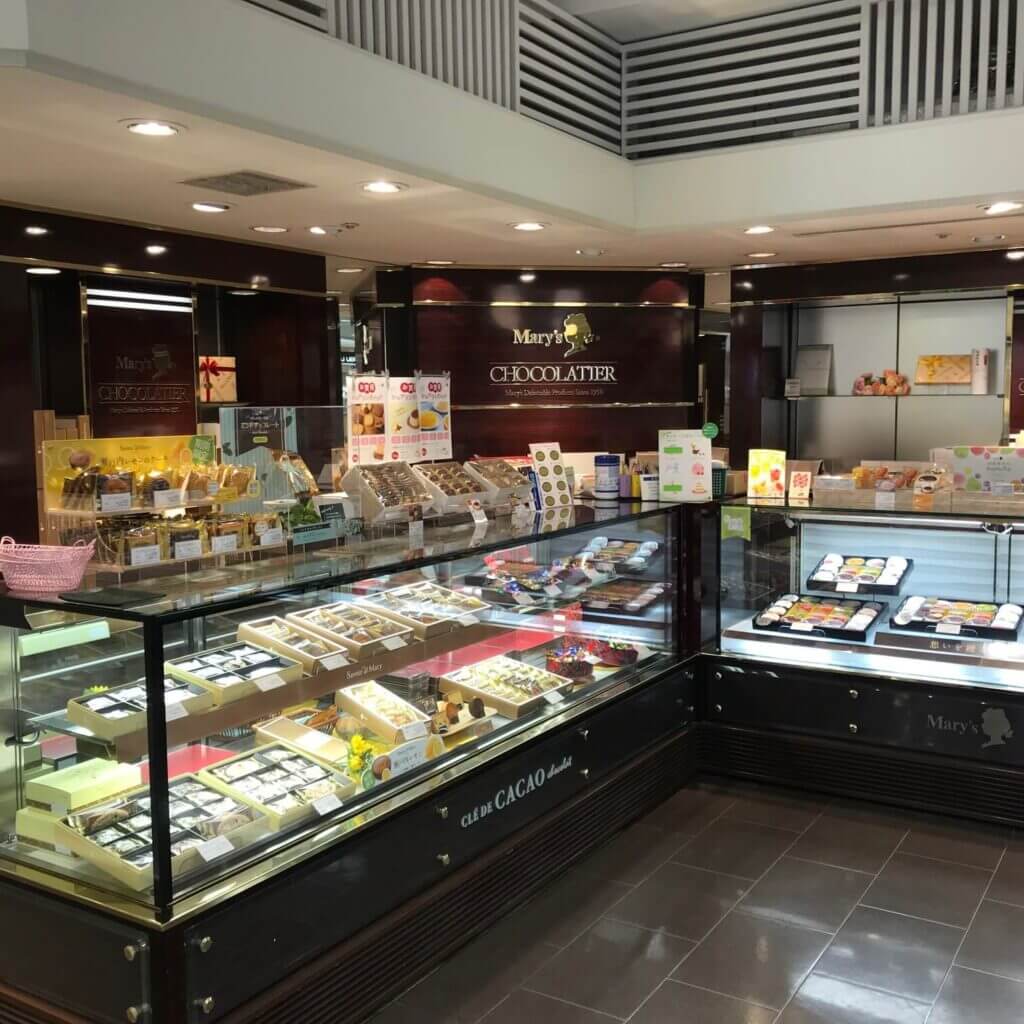
In this post-war period, the confectionary industry tried to revitalize its business again.
Kunio Hara, the later company president of Mary’s Chocolate, learned about the tradition of exchanging cards, flowers, and chocolates on Valentine’s Day from a letter his friend sent from Paris.
In his book, he reflected that he was so focused on the “chocolate part” of the letter, he misinterpreted that there is a culture of women giving chocolate to the men they like in Europe.
He planned to commercialize it, and carried it out in 1958, but only three bars of chocolate and one message card were sold.
Despite the result, this is the very first Valentine’s Day event in Japan.
1960s
After the first event, Mary’s Chocolate researched the celebration of Valentine’s Day.
Later, they succeeded in gradually spreading Valentine’s Day in the nation after started selling heart-shaped chocolate on that customers can ask to write their names.
It started to be covered in the media too.
1970s
Mary’s Chocolate campaign inspired other confectionary companies and the Valentine’s Day Fair began in the department stores.
Culturally, Japanese men did not have the custom of giving gifts to women. But after the advertising slogan was changed to “gifts from women to men,” Valentine’s Day became a national phenomenon as a unique new culture.
Valentine’s Day was a commercial attempt to revitalise the confectionary industry, and was adjusted to Japanese culture.
Unique Traditions of Valentine’s Day in Japan
As much as the history of Valentine’s Day is interesting, there is some surprising tradition on this day.
Let’s take a look at how actually Japanese celebrate Valentine’s Day!
Girls Give Chocolate to Boys
In Western culture, it is common for boys to give gifts to girls. But Japanese culture is the complete opposite.
DID YOU KNOW IN JAPAN || Girls give chocolate to boys they like, and this usually comes with 告白 (kokuhaku: confession) of their feelings about them.
It is considered a great chance for girls to make a move, and it is not rare that Valentine’s Day becomes a couple’s anniversary if the boy accepts!
If you want to know the dating culture in Japan, including 告白 (kokuhaku), check out our post!

Dating in Japan 💘 Everything You Need to Know
Want to know what it’s like dating in Japan? Japanese dating is a very different experience to that of the west so it’s important to follow certain rules.
Popular Gifts
A box of chocolates has been by far the most popular gift since Valentine’s Day started to be celebrated.
Recently, other sweets, such as cake, muffins, or cookies, have become a popular choice too.
Some girls give general goods, such as towels, stationery, or scarves. These gifts often come with sweets.
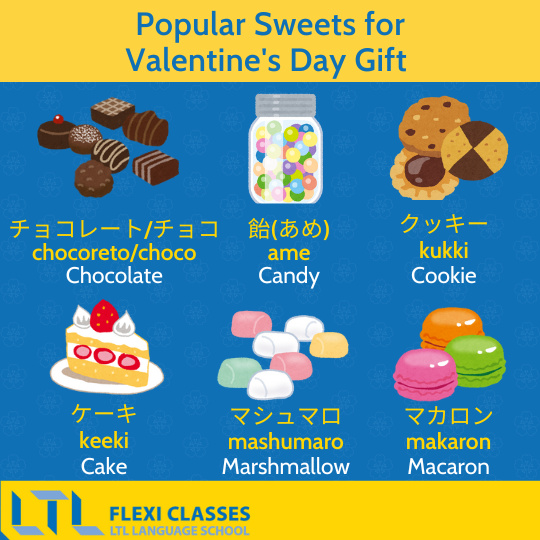
Giving Gifts to Others Besides Lovers
Another unique part of Japanese Valentine’s Day culture is that girls also give gifts to others whom they don’t have romantic feelings for.
There are several types, and each of them has a name with チョコ .
チョコ (choko) is an abbreviation of チョコレート (chokoreto: chocolate)
本命チョコ (honmei choco)
本命チョコ (honmei choco) is a classic type.
It refers to chocolates that girls give as a confession of their feelings to boys. The gifts for the husband or boyfriend are considered honmei choco as well.
Sweets can be homemade to show their affection better. Homemade chocolates are called 手作りチョコ (tezukuri choko).
Buying expensive high-quality chocolate is a popular choice too.
義理チョコ (giri choco)
義理チョコ (giri choco) is a custom of girls giving chocolates to their male co-workers, bosses, or acquaintances.
It is also popular for girls to give their male friends 義理チョコ.
義理 (giri) means obligation in English, so it shows gratitude or politeness.
In dramas or mangas, 義理チョコ is given to the boys since the heroine has no courage yet to give it as 本命チョコ.
The gifts are not that expensive since there are no romantic feelings involved. They could be carefully chosen to avoid misunderstanding from the boys think that the girls actually have feelings for them.
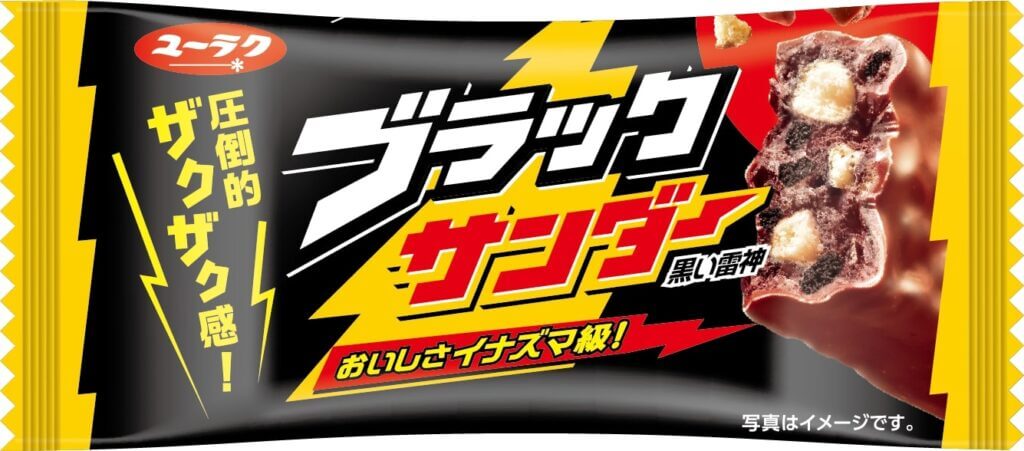
ブラックサンダー (Black Thunder), one of the cheapest chocolate sweets, had a campaign with the advertising slogan “一目で義理とわかるチョコ” (you’ll know it’s giri choco at the first sight).
Due to this smart campaign, other companies targeted increasing sales by advertising their products as 義理チョコ.
友チョコ (tomo choco)
友チョコ (tomo choco) refers to the gifts exchanged between female friends. 友(tomo) means friend in Japanese.
There are no romantic feelings involved in this, so they enjoy celebrating their friendships with chocolates.
Some boys who cannot receive any chocolate give each other instead, too.
逆チョコ (gyaku choco)
逆チョコ (gyaku choco) is when boys give gifts to girls to tell their feelings.
As 逆 (gyaku) means the opposite in English, this one follows Western Valentine’s Day culture. But this case is rare!
自分チョコ (jibun choco)
自分チョコ (jibun choco) is when you buy chocolate for yourself.
自分 (jibun) means myself in English, so this is like rewarding yourself with luxurious chocolates.
ファミチョコ (fami choco)
ファミチョコ (fami choco) refers to chocolate to male members of a family.
This also can be a small gift to the whole family to enjoy together at home.
ファミ is an abbreviation of ファミリー (famiri: family).
推しチョコ (oshi choco)
推しチョコ (oshi choco) became popular a few years ago.
推し (oshi) is your favourite member in an idol group, a character from anime or drama, an actor, a sports player, or any person you admire.
This word is similar to ファン (fan), and girls express their feelings through chocolate.
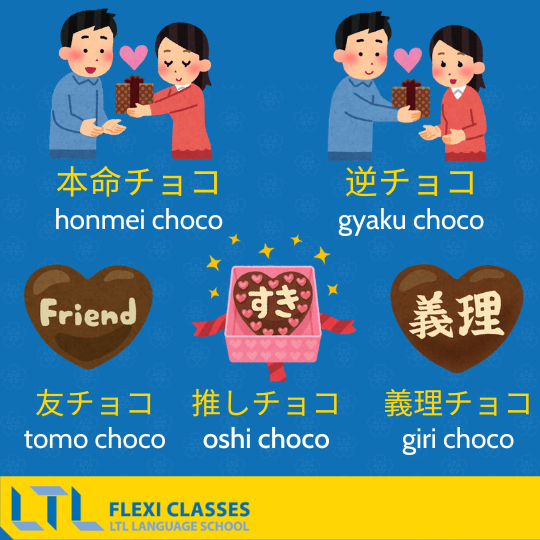
As there are many different types of feelings contained in the gifts, you can basically give chocolate to anyone you know 😍
White Day || ホワイトデー
White Day ( ホワイトデー ) is on March 14th, just a month after Valentine’s Day.
It is a day for boys to give a return gift for the gifts they received from girls on Valentine’s Day.
This day could be a day they will answer if they accept or reject 告白 (kokuhaku) from girls too.
Initially, it started in 1977 as one confectionary company’s marketing campaign to sell marshmallows and called it “Marshmallow Day.”
But later, the National Confectionery Industry Association started calling it “White Day.”
Popular Gifts for White Day
Popular gifts are chocolate, cookies, candy, flowers or accessories.
Some boys intentionally avoid giving chocolate to differentiate from Valentine’s Day gifts they received.
It used to be popular to select gifts with white colour, but there is more variety in gifts like Valentine’s Day.
There is also an unspoken rule for boys to buy double or triple-priced gifts from the gifts they received from girls.
If there is Japanese person you know, why don’t you give chocolate on February 14th?
Let us know what you think about this unique Valentine’s Day culture in Japan.
Share how you celebrate Valentine’s Day in your culture in the comment section below 🤩
Do you want to say something romantic in Japanese on Valentine’s Day along with your gift? Check out our posts on how to express your love in Japanese:)
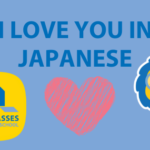
Express Your Love 💖 How to Say I Love You in Japanese
Today we open our hearts and teach you how to express you love in Japanese – welcome to our guide on how to say I love you in Japanese.
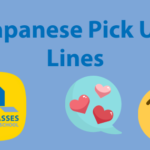
Japanese Pick Up Lines 😉 28 Ways To Raise Your Japanese Rizz
Let’s learn some Japanese pick up lines together. We have a huge total of 28 Japanese chat up lines that will break the ice with your crush! Let’s discover.
BONUS || If you want to find out more about Valentine’s Day celebrations in Asia, why not check out our guide to the six different Valentine’s Days in China!
Valentine’s Day in Japan || FAQs
What is Valentine’s Day called in Japanese?
It’s バレンタインデー (barentainde).
We usually call it バレンタイン (barentain) without デー.
When was Valentine’s Day introduced in Japan?
The very first product line of the confectionary gift was back in the 1930s.
But it became a national phenomenon after the 1970s.
Do Japanese celebrate Valentine’s Day?
Yes. But the tradition is different from Western Valentine’s Day.
Girls give gifts to boys. The gifts can be given to lovers, co-workers, friends, family, or even to yourself.
What is White Day?
White Day is a month after Valentine’s Day, so it’s on March 14th.
Boys are expected to give a return gift to girls.
Want More From LTL?
WANT TO LEARN JAPANESE? Check out our online Japanese courses here.
We offer a 7-day free trial to all new students where you can study 24/7.
What about studying Japanese in Japan instead? We’ve got your back. Our Japanese courses in Tokyo can either be taken in small groups of no more than 5 students or individually for a more tailored experience.
We even offer incredible homestay experiences in Tokyo as well.
Come and be a part of this amazing community.









